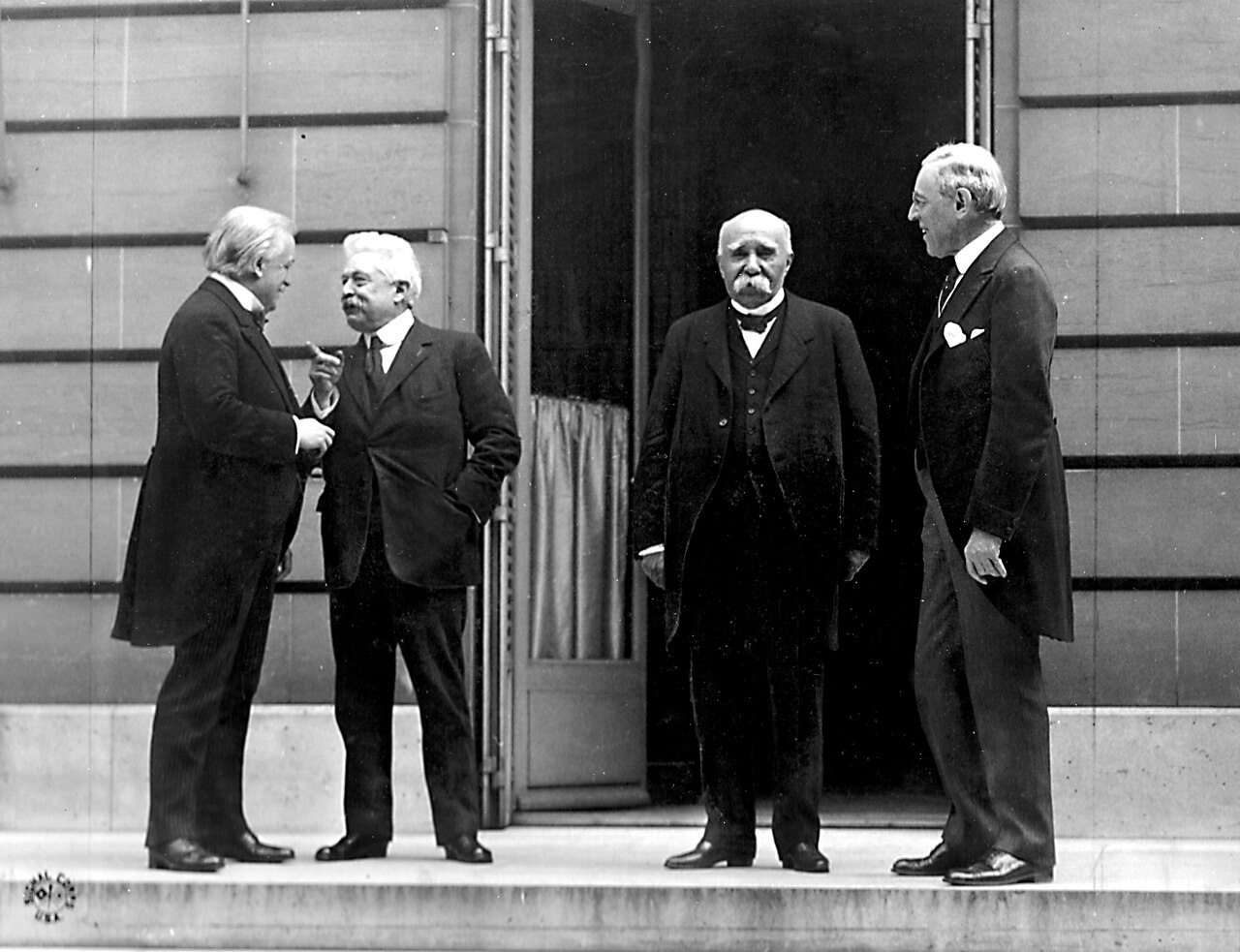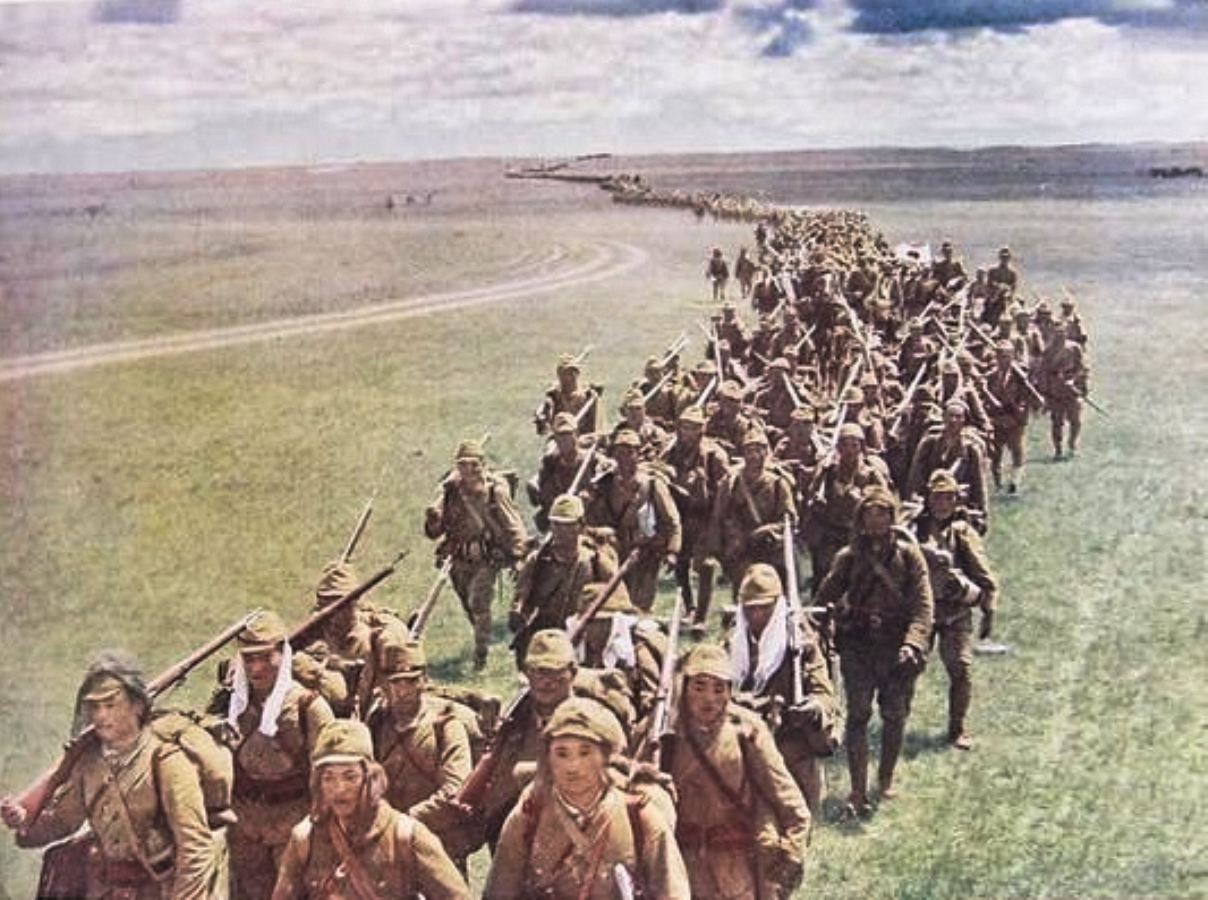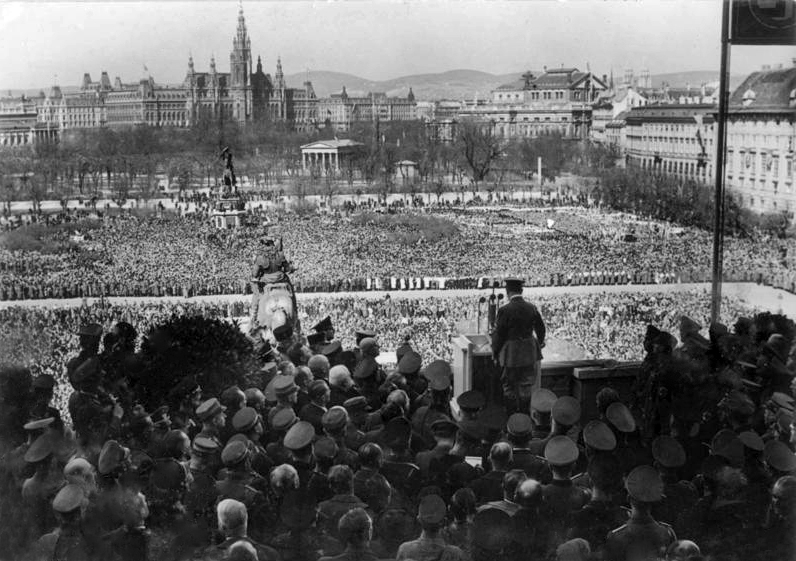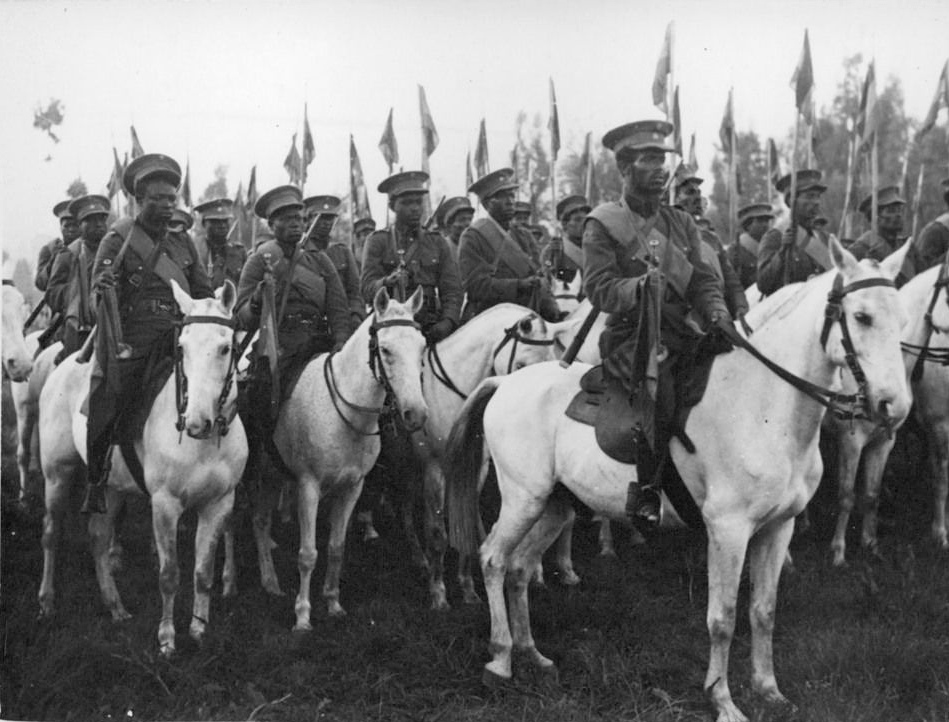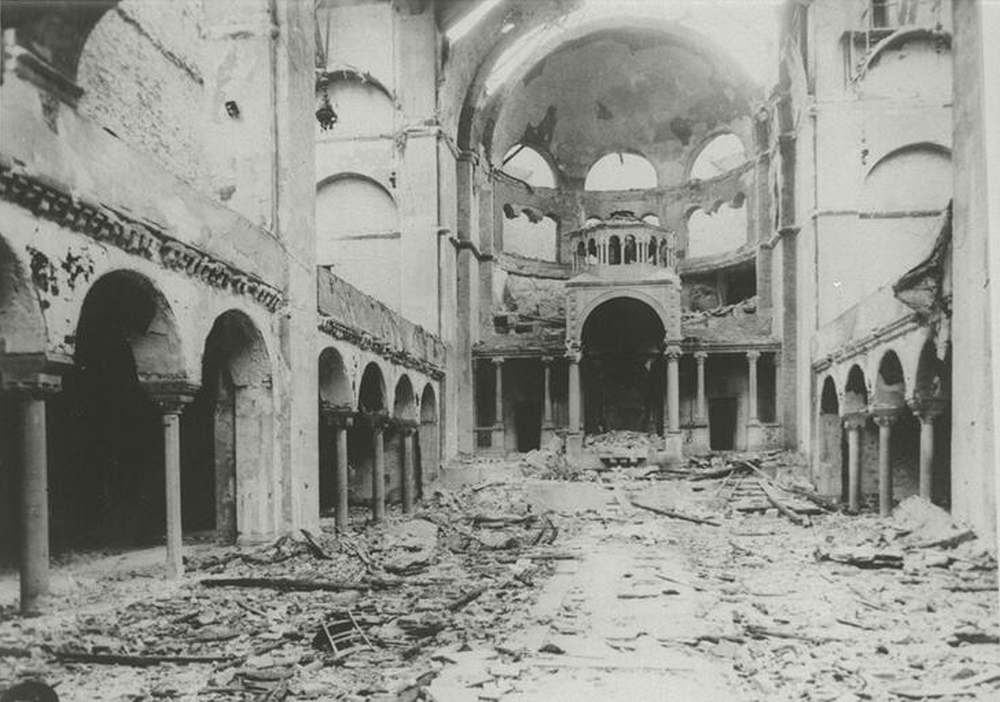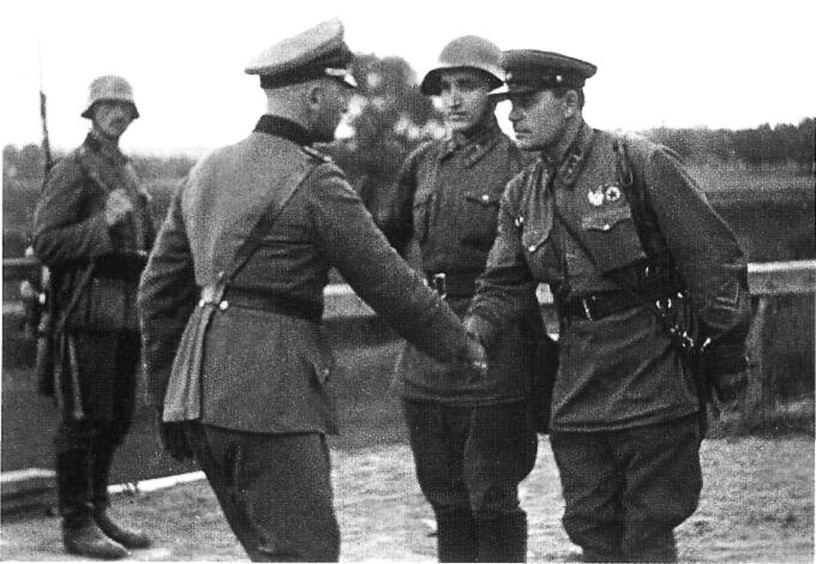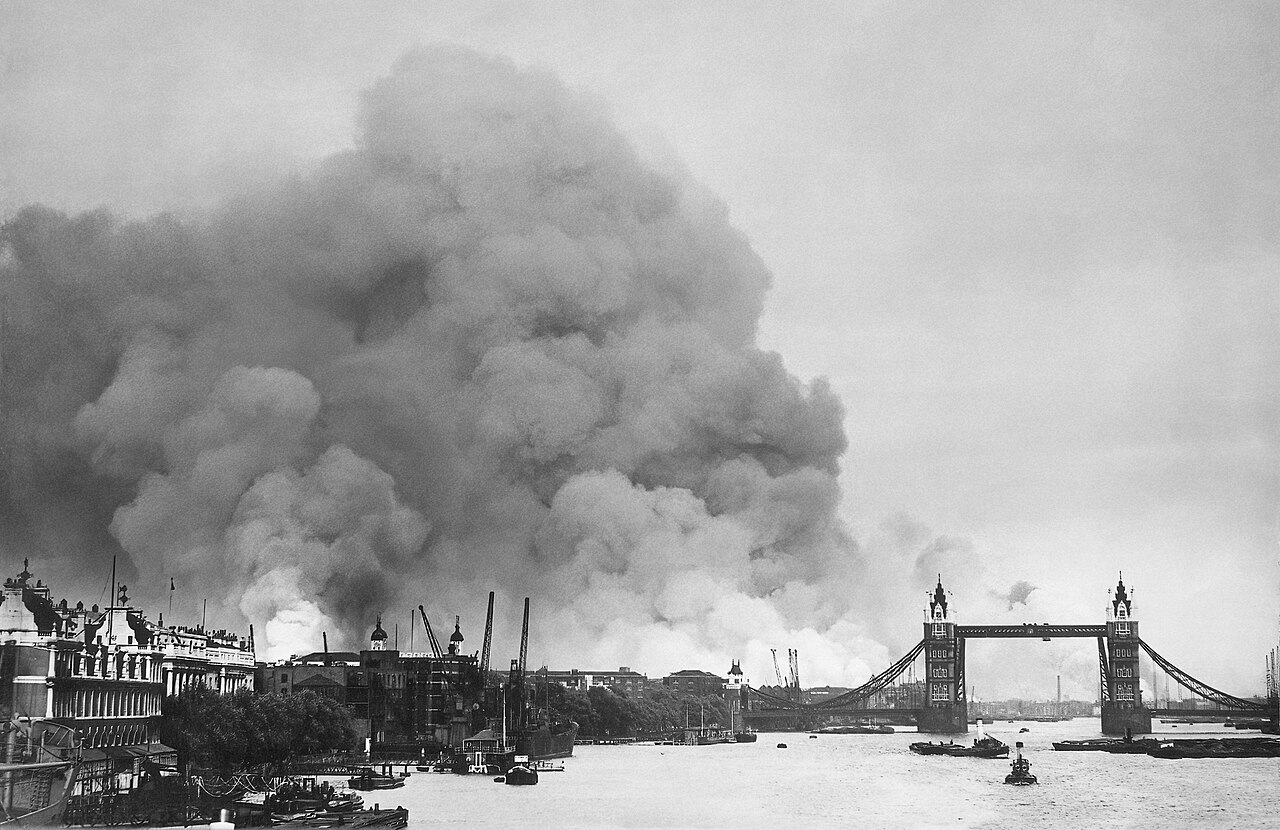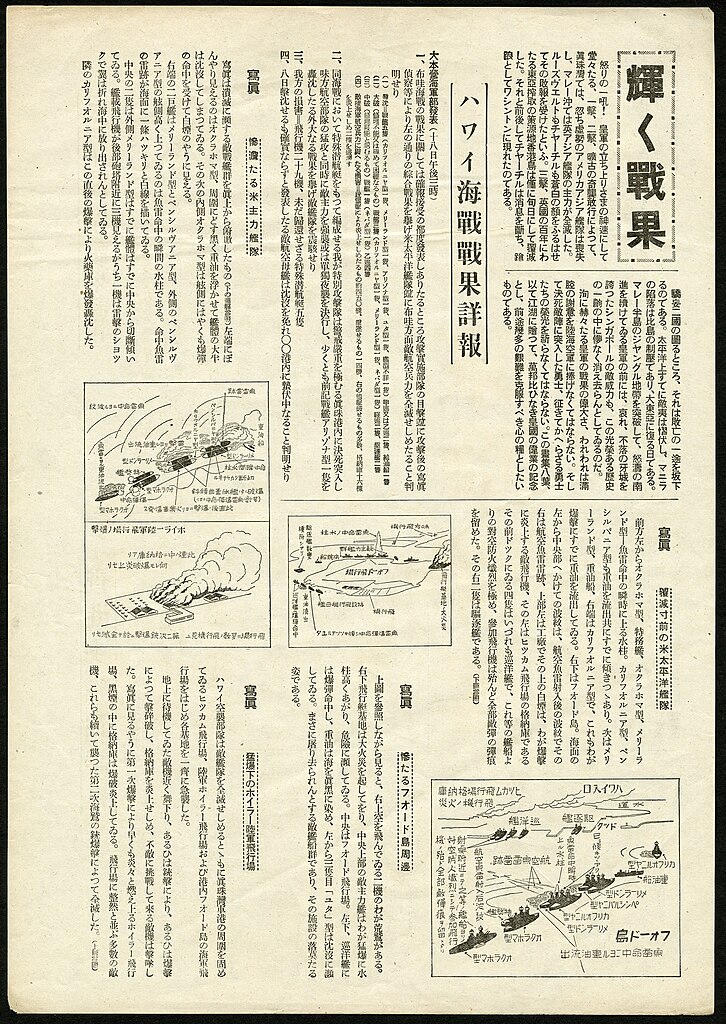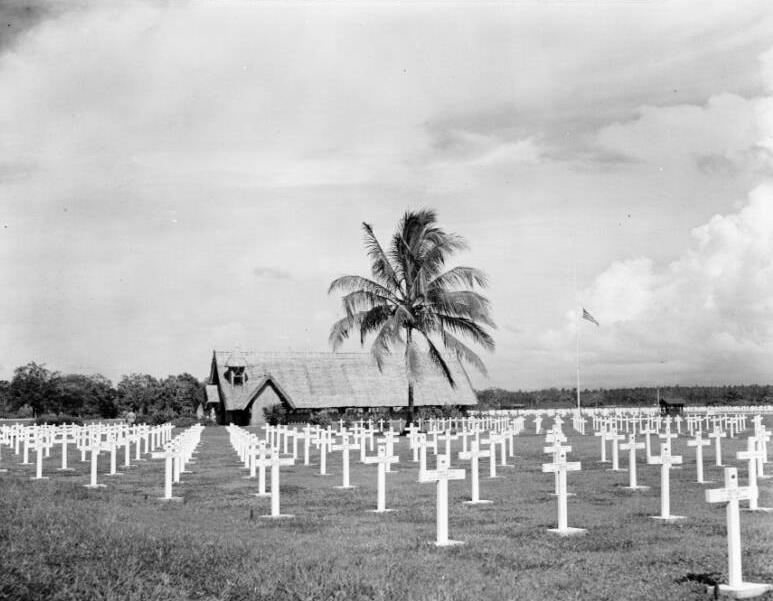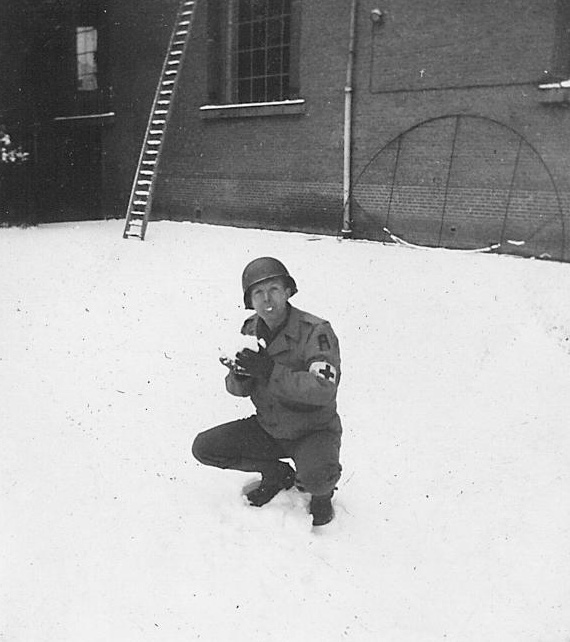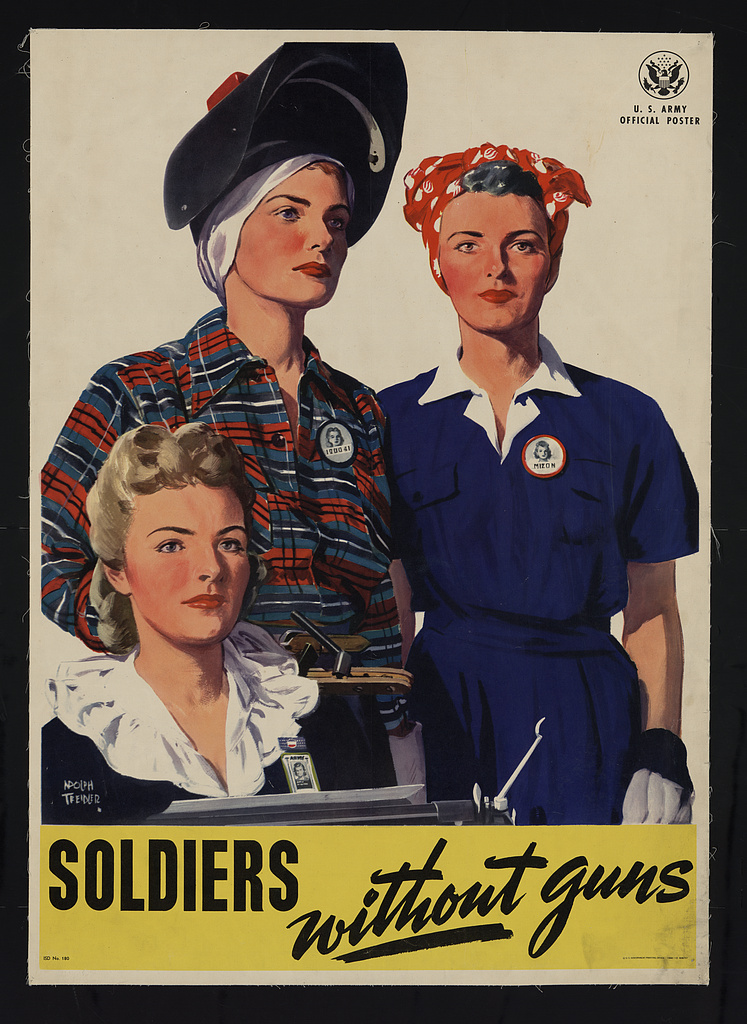Ray Notgrass: June 6, 2024, marks the 80th anniversary of D-Day, when Allied forces invaded Nazi-occupied Europe during World War II. On today’s Exploring History podcast, we’ll explain the causes of World War II, give a brief history of the war including the significance of D-Day, and tell how the world changed as a result of the war.
Titus Anderson: [music in background] Welcome to Exploring History with Ray Notgrass, a production of Notgrass History.
Ray Notgrass: It’s been 80 years since D-Day. That day was the beginning of the end of World War II in Europe. Next year, 2025, will mark the 80th anniversary of the end of the war.
To give some historical perspective on the length of time we’re talking about, the period from the end of the Civil War–1865–to the end of World War II–1945–was 80 years. My point is that, just as the world of 1945 was very different from the world of 1865, our world today is quite different from the world that existed in 1945. The story of what that generation of Americans did to help end World War II, and why that generation has been called the Greatest Generation, is a story that needs to be retold and remembered. As time goes by, fewer and fewer veterans of World War II are still alive. So this podcast is dedicated to the story of World War II. Books upon books have been written on just about every aspect of the war, but perhaps this overview will encourage you to explore the subject in more depth on your own.
People often say that war “broke out” in a particular place or between two countries, but wars never just “break out.” The contributing causes that lead to war usually go back many years. So it was with World War II. To understand why this war developed as it did, we must go back to the end of World War I, which at the time was called the Great War, since people then did not know that another world war was coming.
After four years of terrible, deadly conflict, from 1914 to 1918, Germany surrendered to the Allied nations that had opposed them, principally Great Britain, France, Italy, and the United States. The leaders of the Allied powers met in Versailles, France, to hammer out the terms of a peace treaty. The goal of the European allies, Britain, France, and Italy, who had borne the brunt of the war, was to make Germany pay. By contrast, the American president, Woodrow Wilson, brought to the treaty negotiations high ideals about creating an international arrangement that would prevent future wars.
In the treaty, the Allies forced Germany to give up its overseas empire. The German government had to dismantle its armies and much of its navy and merchant marine. But the hardest terms for Germany to swallow were the admission of guilt for causing the war and the requirement to pay heavy reparations or payments of money to the Allies. Germany only ever paid part of the reparations because the German economy struggled to recover after the war. The guilt clause created bitterness in Germany, and that bitterness was one factor that led to World War II.
President Wilson agreed to these harsh terms in order to get the other leaders to agree to starting the League of Nations. But the U.S. Senate rejected the Treaty of Versailles. The League of Nations came into existence, but the U.S. was never a member. Germany and the new Soviet Union, which had begun in 1917, were not allowed to be members. The League was never a force to be reckoned with in handling international conflicts. Nations generally took matters into their own hands as they saw fit, without consulting or even considering the League.
During the 1920s, countries tried to find their way through a confused and confusing world scene. The devastation of the Great War left many countries struggling economically. The governments of several countries experienced upheaval. The world wondered what to do with the new Communist country of the Union of Soviet Socialist Republics–the U.S.S.R., also called the Soviet Union or Russia. During the 1920s, several countries agreed to idealistic treaties that limited their military and naval strength and attempted to outlaw war as a way to settle conflicts. The United States eventually recovered economically from the war, but Americans were reluctant to become involved in any further international conflicts.
In several countries strong personalities took advantage of the unsettled situation to seize power. In Japan people who favored an aggressive use of the military came to power in the late 1920s. Using a variety of excuses to cover their aggression, Japan invaded the province of Manchuria in China in 1931. The League of Nations stood by helplessly. The next year, Japan bombed the city of Shanghai in China and later committed atrocities in other places in China. When the League of Nations protested Japan’s actions in 1935, Japan simply withdrew from the League. Japan also attacked and overran several other countries in the Pacific region.
In Italy the lack of a tradition of democracy and the presence of economic problems opened the door for Benito Mussolini to put himself forward as a national savior. Mussolini had fought in the Great War but was injured in 1917. Following that war, Mussolini organized the Fascist Party, named for the fasces, a bundle of rods that was a symbol of authority during the Roman Empire. The Fascists bullied other political parties into submission to their will. Mussolini played on people’s fears and gained wide support. In 1922 Mussolini and his followers marched on Rome to defend the capital from Communists, although no Communist threat was known to exist. The constitutional monarch, King Victor Emmanuel III, asked Mussolini to form a new government. Mussolini then changed the election laws in his favor and took control of the Italian Parliament. Soon the Fascists were the only legal political party in the country.
In Germany Adolph Hitler, a veteran of the German army during the Great War, joined and soon became leader of the National Socialist or Nazi Party in the German state of Bavaria. Like Mussolini, Hitler played on people’s fears regarding the struggling economy as well as what he called the danger of ethnic impurity. For Hitler, the fault for Germany’s problems lay with those who had humbled Germany and especially with the Jews. In Hitler’s mind the Jews had too much power and were a stain on society.
In 1923 Hitler failed in an attempt to seize the government of Bavaria. He went to prison for over a year. During that time he wrote the book Mein Kampf (which means My Struggle), in which he clearly outlined his goals for conquest. After his jail term, Hitler and the Nazis continued to gain power. In 1933 the aging German president asked Hitler to form a government. The Nazis did not have a majority in the legislature, so Hitler called for new elections in the hope of gaining a majority. A week before the election, a fire destroyed the legislative building. The Nazis probably set the fire, but they blamed the Communists and declared martial law. The Nazis pushed through laws that gave Hitler dictatorial powers for four years. By the end of those four years, Hitler’s opponents were in exile or in jail, and the Nazis had gained total control of Germany.
In 1935 Hitler announced that he was going to rearm Germany in defiance of the Treaty of Versailles. The next year Hitler stationed troops in the Rhineland, the western province of Germany that bordered France, in direct violation of the Treaty of Versailles. Hitler said that Germany needed more lebensraum or living space. This meant that he was planning to invade and take over other countries. In 1938 Hitler took over Austria. Later that year, Hitler announced his intention to take over the Sudetenland, a largely German speaking part of northern Czechoslovakia that bordered on Germany.
The British prime minister, Neville Chamberlain, met with Hitler in Munich, Germany, to discuss the issue. Hitler said that he would end his aggression if he were allowed to take over the Sudetenland. Britain and France agreed to allow Hitler to do this. This policy was called appeasement. Chamberlain hoped and believed that appeasing Hitler on this issue would prevent war. Chamberlain returned to Britain, got off his plane, held aloft the agreement that Hitler had signed, and said that he believed he had achieved “peace for our time.” But Chamberlain was wrong. Six months later, Hitler’s army took over the rest of Czechoslovakia.
Elsewhere, in 1936 Italy had annexed Ethiopia, a country in northeastern Africa, and resigned from the League of Nations. Later that year, Italy and Germany announced a mutual defense treaty. Mussolini declared that the axis of the world now ran between Rome and Berlin. For this reason the two countries became known as the Axis powers. Japan joined the Axis the next year. Italian forces later invaded and took control of Albania.
In July of 1937 Japanese forces invaded China, and Chinese armies fought back. This is often seen as the start of World War II in Asia.
Hitler put policies in place in Germany that were based on his belief in Germanic superiority and on his hatred of the Jews. The legislature passed laws that discriminated against the Jews. Hitler forced Jews to wear identifying badges, the Nazis burned Jewish synagogues, and what the Nazis called the final solution of destroying Jews in concentration camps began. Many people in other countries either didn’t believe the reports coming out of Germany or simply looked the other way. On November 9-10, 1938, the Nazis unleashed a series of attacks on Jewish persons, synagogues, and businesses in Germany, Austria, and Czechoslovakia. The attacks came to be called Kristallnacht or the Night of Broken Glass. Thousands of Jews were rounded up and taken to concentration camps.
Meanwhile the United States tried to maintain a policy of strict neutrality regarding what was happening in Europe, but Congress and President Franklin Roosevelt did give some assistance to Britain and France. Roosevelt increasingly used language that showed he favored giving help to the Allies. In 1937 Roosevelt said that the aggressor nations needed to be “quarantined.” He meant to do this by strengthening the forces of the countries that opposed the Axis powers. In 1940 Roosevelt said that the United States needed to be the arsenal of democracy, providing friendly nations with weapons to fight against aggressor nations led by dictators. In 1941 he initiated a program that allowed Britain to borrow military supplies from the United States and give them back after the war. Roosevelt had to win over skeptical members of the public and Congress, but as conflicts developed in Europe and Asia, it became more and more clear that the United States was going to be involved in some way.
But back to Europe. In 1939 Britain and France knew that the German government intended to take Poland to its east. Britain and France declared that any attack on Poland would bring about a state of war with Germany. The two allies hoped that the Russian presence to the east of Poland would keep Germany from attacking Poland, which lay between them. Americans didn’t quite know what to do about the Soviet Union. Joseph Stalin was dictator there, and Americans feared the influence of Communism everywhere in the world, but most American and British leaders saw Russia as a potential helper against German aggression. It was a matter of believing that an enemy of my enemy is my friend, so American criticism of Russia was minimal. Only years later did the truth come to light about the millions of people Stalin killed in his political purges and cruel suppression of dissent.
Most people in Europe and America understood that Germany and Russia were adversaries, so the world was shocked when, on August 23, 1939, the two countries signed a mutual non-aggression treaty, promising not to attack each other. What was not announced was a secret agreement on how the two countries planned to divide up Poland between them.
On September 1, 1939, Germany invaded Poland. The Soviet Union moved into Poland from the east to claim its share. Two days later, Britain and France declared war on Germany. The German invasion of Poland is usually seen as the start of World War II in Europe. The United States began moving away from its position of neutrality and began actively selling weapons to Britain. Britain sent troops to France to defend against a German invasion.
In April of 1940, Germany invaded and seized Denmark and Norway. The next month,
Hitler turned his attention to France. Following the Great War, France had built a series of forts called the Maginot Line along its border with Germany. To invade France, German forces simply went around the line by going through the Netherlands, Belgium,
and Luxembourg.
The onslaught of the German army into France trapped a force of about 300,000 mostly British troops against the English Channel at the town of Dunkirk in northern France. The British government called for every available ship and boat in Britain to go to Dunkirk to rescue the troops. The evacuation at Dunkirk was one of many courageous acts that the British people performed during the war.
German troops advanced on Paris and took the city in June of 1940. To humiliate the French, Hitler had French officials sign the document of surrender in the same railroad car and on the same spot in which German officials had signed the armistice in 1918 that ended the Great War. Italy, seeing how the conflict was going, declared war on France and Great Britain.
The fall of France and other nations left Great Britain as the only declared enemy of Germany still able to fight. Newly installed prime minister Winston Churchill vowed that Britain would never surrender. Hitler planned to invade Britain, and in the summer of 1940, the German Luftwaffe (or air force) began a fierce attack on the island nation of Britain that came to be called the Battle of Britain. Air raid sirens and the need to take shelter became daily occurrences. German bombers targeted the major cities and especially strategic factories. The Germans destroyed between a third and a half of London.
However, the Royal Air Force (the RAF) performed brilliantly and downed many German
planes. This significantly weakened Hitler’s air power. In addition, the British government and the British people refused to bow to Hitler. Because of the failure of the German air attack, Hitler called off the invasion. British prime minister Winston Churchill called the efforts of the British during the Battle of Britain “their finest hour.”
In September of 1940, Germany, Italy, and Japan signed an agreement which said that if a country declared war against any one of them, the other two would join forces and declare war on the opposing nation.
In 1941 Germany and Italy took control of Greece, Hungary, Romania, Bulgaria, and parts of northern Africa. Almost all of Europe was now under Axis control.
Japan and the Soviet Union signed a nonaggression treaty in April of 1941. This allowed Russia to concentrate on the German threat in Europe, and it gave Japan a free hand to escalate the war in Asia. In June of 1941, Japan seized French Indochina (the area that later became Vietnam). The U.S. responded by ending almost all trade with Japan and freezing Japanese assets in the States.
Seeing that the U.S. was becoming more involved in the conflict, Japan took a two-pronged approach. It sent a peace mission to Washington in November of 1941 while preparing for a full-scale attack on U.S. possessions. Japan insisted that the U.S. release the frozen Japanese assets, supply Japan with all of its demands for gasoline, and end all aid to China. The United States refused to accept these demands.
On the morning of December 7, 1941, the Japanese government sent a secret message to its delegation in Washington to break off negotiations. The message was to be presented to the American government just before the attack on Pearl Harbor, but delays prevented it from being delivered until after the attack had begun.
December 7, 1941, was a Sunday. Millions of Americans attended church services that morning knowing that war was raging around the world and wondering when it might engulf their own country. Professional football teams played their scheduled games that afternoon. Families were making plans for the upcoming Christmas holidays. In the early morning hours, Japanese air and naval forces launched a massive surprise air assault on the American naval and air bases at Pearl Harbor in Hawaii, an American territory at the time. In two hours the Japanese destroyed some eight battleships, 150 American planes, and inflicted other severe damage on American installations. Some 2,400 enlisted personnel and civilians were killed and another 2,000 were wounded. That day the Japanese also attacked American bases at Wake Island, Midway Island, Guam, and the Philippines, along with British positions in Hong Kong and the Malay Peninsula.
The American government was apparently aware that a large Japanese buildup was underway, but U.S. officials assumed that the main target was going to be in Asia. American intelligence intercepted the message that the Japanese government sent to its delegation in Washington on December 7, and the American government issued a non-specific warning to American bases in the Pacific that something was about to happen. But the warning arrived too late at Pearl Harbor.
The day after the attack on Pearl Harbor, President Roosevelt addressed Congress and asked for a declaration of war. Congress passed the declaration that day with only one dissenting vote. Germany and Italy declared war on the United States three days later. The conflict had become a world war, and the United States was now directly involved.
That lone dissenting vote on the declaration of war was cast by Jeanette Rankin, congresswoman from Montana. Ms. Rankin served two terms in the U.S. House. She was elected in 1916 and the next year voted against American entry into the Great War. In 1918 she ran for the U.S. Senate and lost. She was next elected to the House in 1940 and cast the only vote against U.S. entry into World War II. She did not run for reelection in 1942.
America’s entry into the war was eventually the decisive factor in the ultimate Allied victory, but the tide that brought this about did not turn for some time. Through most of 1942, the Axis powers advanced and the Allied forces retreated in both the Atlantic and Pacific regions.
In 1941 and 1942, the Japanese overran Allied positions throughout the Asian rim of the Pacific, including American and British possessions and countries that had joined with the Allies. In late December 1941, President Roosevelt ordered the American commander in the Pacific, General Douglas MacArthur, to leave the Philippines. As MacArthur was leaving, he declared, “I shall return.”
The Japanese and American naval forces engaged in battles in May 1942 in the Coral Sea north of Australia and in June at Midway Island in the Pacific. American forces defeated the Japanese in both of these battles and inflicted heavy losses on the Japanese fleet. These losses halted the Japanese advance in the Pacific and weakened Japanese naval power for the rest of the war.
By June of 1941, the German army had taken almost all of the other countries in Europe. Hitler began concentrating on an invasion of Russia. German forces blanketed a wide area and caused considerable damage, but they failed to take Moscow by the end of 1941. The Russian winter is a merciless foe, and the Germans bogged down in early 1942 without conquering Russia. Meanwhile, German and Italian submarines in the Atlantic wreaked havoc on American shipping. The Axis fleet sank over 400 American vessels in American coastal waters, some within sight of the U.S. mainland.
The beginning of Allied success in both the European and the Pacific theaters of operation came in November of 1942. In that month, American forces began attacking the Japanese position on the island of Guadalcanal in the Solomon Islands northeast of Australia. The assault took six months, but the Americans eventually cleared the Japanese from the island.
Through 1943 and into 1944, Allied Army, Navy, and Marine forces conducted slow, often costly sweeps of Japanese positions in the Pacific. The Allied goal was always to be moving toward Tokyo. The Allies did not try to take every island held by the Japanese. They leapfrogged over some islands, leaving Japanese forces on them cut off from supply lines. The scattered units eventually had to surrender. Remarkably, for many years after the war, Japanese soldiers who had not heard—or had not believed—that the war was over were found on remote islands.
In Europe in late 1942, the Russian army assumed the offensive against the invading Germans. At the same time, Allied forces moved against German positions in northern Africa. American, British, and Russian leaders had long debated where to mount the first major assault against Germany and Italy. Russia wanted it to be on its own turf, where it could push the German forces back toward Germany. Finally, however, the decision was made to launch a coordinated attack on German forces in North Africa. From there the armies of freedom could strike Italy. Churchill called the Mediterranean region the soft underbelly of the Axis. British and American forces in northern Africa moved from opposite directions against the German army that was led by Erwin Rommel. The British under Bernard Montgomery headed west from Egypt, and the Americans under Dwight Eisenhower moved east from Morocco and Algeria. The Allies caught the Germans in a giant pincer, and Rommel’s forces surrendered in Tunisia on May 13, 1943. The Allies then controlled northern Africa.
British and American forces invaded and took control of the island of Sicily in July of 1943. The move surprised the Italians and knocked Mussolini out of power. The new Italian government indicated its willingness to surrender and even switch sides to join the Allies. Negotiations between Italy and the Allies dragged on until September, by which time German troops had considerably strengthened their positions in Italy. The Allies finally invaded Italy at Salerno on September 9, 1943. The fighting that winter was extremely difficult in mountainous terrain during terrible weather. But the Allies prevailed
and began moving toward Rome. Americans took Rome on June 4, 1944, two days before D-Day.
Meanwhile, Axis attacks against Allied shipping in the Atlantic were brought under control by May of 1943 with improved radar, better intelligence on submarine positions, and the use of convoys to protect vessels taking supplies to Europe. Also during 1943 and into 1944, Allied bombing of Germany took a heavy toll. The American Army Air Force attacked specific targets such as industrial complexes during the day, and British RAF bombers blanketed selected cities in nighttime raids. The Allies lost many planes, but the damage to Germany was considerable. One specific purpose for the air attacks was to weaken Germany ahead of the upcoming Allied invasion of Europe.
The Allies agreed that Germany had to be defeated before Japan. Military planners decided that the major thrust to accomplish this would come through a massive invasion along the northern coast of German-occupied France. The Allied armies would then retake Paris, move east through Belgium, and strike Germany itself. About one million American troops were sent to Britain during 1943 and early 1944 to prepare for the assault, the code name for which was Operation Overlord. Dwight Eisenhower was named commander of the operation.
The German army had heavily fortified the northern French coast with machine gun positions, minefields, and barbed wire. Hitler expected the Allied troops to land at Calais, where the English Channel was most narrow. Eisenhower sent a decoy maneuver there, but the main landing actually took place to the west at Normandy Beach and other nearby locations. Air cover and paratroopers moved in early to soften the German resistance. Early on June 6, 1944, 4,000 ships carrying 150,000 troops (about a third of them Americans) began landing in northern France. German resistance was strong, and about 5,000 Americans were killed or wounded that day. However, the Allied forces were able to take control of the beaches; and within two weeks a million Allied soldiers had invaded occupied France and were moving inland.
Allied troops liberated Paris on August 25, 1944; and the Americans turned east to chase the retreating Germans back into Germany. Meanwhile, another Allied force landed in southern France and began heading north.
Now let’s back up for a moment and go back to domestic affairs in the United States during this period. In 1940 Franklin Roosevelt had run for and won an unprecedented third term as president. As the likelihood of American involvement in the war was increasing that year, Democrats urged voters not to change horses in the middle of the stream. Four years later, in 1944, as the war seemed to be heading for an Allied victory, America headed into another presidential election. Roosevelt was tired and ill, but he allowed himself to be nominated for a fourth term. Roosevelt won, but his margin of victory was the smallest of his four presidential victories. His vice presidential running mate in 1944 was Senator Harry Truman of Missouri, not the best known candidate for the job but someone who was widely respected. Roosevelt, however, hardly knew him.
Allied efforts in the Pacific continued to go well in late 1944. In October General Douglas MacArthur was indeed able to return to the Philippines. The Battle of Leyte Gulf in the Philippines was the largest naval engagement of the war. Some Japanese pilots made kamikaze suicide crashes into American vessels. The American fleet won the battle despite heavy losses.
In Europe the Allied advance toward Germany bogged down before reaching the German border. In December of 1944, a German force broke through the Allied line and made a fifty-mile bulge in Belgium back toward Paris. The Battle of the Bulge was fought during some of the coldest weather Europe had seen in many years. The Allies were forced to fall back, but the Germans overextended their supply lines and could not maintain their momentum. The battle was a temporary setback for the Allies, but it only delayed and did not stop their advance.
As the Americans raced toward the German capital of Berlin from the west, Russian troops were advancing on Berlin from the east. The contest was not simply a friendly challenge between allies. Both sides knew that whoever controlled Berlin would hold a powerful position in post-war Germany. Despite Churchill’s urging of Eisenhower to take Berlin, the Allied commander chose instead to concentrate on the destruction of the remainder of Germany’s army. The Americans backed off and allowed the Russians to get to Berlin first.
In February of 1945, Roosevelt, Churchill, and Stalin met at Yalta on the Crimean Peninsula. There Roosevelt made significant concessions to Stalin in an effort to insure that Russia would help the Allies fight against Japan and would also participate in the post-war United Nations. Roosevelt agreed to a Soviet sphere of influence in Eastern Europe. This meant that the Russians would oversee the installation of new governments in Poland, Czechoslovakia, Hungary, and other countries, which in turn meant that those governments would be Communist. The leaders agreed to partition Germany into British, American, Russian (and later French) zones of control. The Russians also received certain islands from Japan and areas of China over which it claimed control. Roosevelt believed that these were minor concessions that he could make because he believed the Russians were going to control those areas anyway. He made the concessions in the hope of obtaining the greater goals he wanted to achieve.
On March 7, 1945, Allied troops entered Germany from the west by crossing the bridge
over the Rhine River at the town of Remagen. The defeat of Germany seemed to be only a matter of time. Then on April 12, 1945, Franklin Roosevelt died of a cerebral hemorrhage in Warm Springs, Georgia, a place he often visited to swim in the warm spring waters to get relief from the physical pain he suffered as a result of his paralysis from polio. Later that day, Harry Truman was sworn in as the new president. Victory in Europe was less than a month away.
On April 28 Italians who had opposed the rule of Mussolini captured and murdered him. Two days later, Adolph Hitler committed suicide. The German military high command asked for surrender terms on May 2, and on May 7 they agreed to an unconditional surrender. May 8 was celebrated as V-E Day (Victory in Europe).
In February of 1945, American troops landed on and eventually took the island of Iwo Jima at a cost of 20,000 casualties, including 7,000 dead. Iwo Jima was only 750 miles from Japan and provided an important staging point for a final assault on Japan. The island of Okinawa fell to the Allies in June. With the end of the German threat, the Allies
wanted to find the best way to defeat Japan quickly. Allied air attacks and sea-based bombardments were taking a toll on Japan, but military planners feared that an all-out invasion of the island nation might cost a quarter million American lives or more.
In 1939 Albert Einstein had written to President Roosevelt to inform him that he thought it was possible to split an atom and thus release an enormous amount of energy. He also said that he believed the Germans were pursuing research for the purpose of developing an atomic weapon. Roosevelt quietly began the Manhattan Project for the U.S. to develop its own nuclear capabilities. The first atomic device was exploded at Alamogordo, New Mexico, on July 16, 1945. No one really knew what potential destructive power the bomb had, but Truman gave the approval for production to continue. Serious discussion took place within the American government on how and whether to use the new device. Experts estimated that about 20,000 deaths might occur with the use of one of the bombs.
Americans dropped the first atomic bomb on the city of Hiroshima in Japan on August 6, 1945. Eighty thousand people were killed immediately, and the toll rose to 140,000 before the year ended. Russia came into the war against Japan on August 8. The next day, Americans dropped the second and last atomic bomb on the city of Nagasaki. The destruction there was similar. Japan surrendered unconditionally on August 14 (V-J Day); and the formal surrender took place on September 2, 1945. The long, costly war was finally over.
The courage and sacrifice of the American armed forces were matched by the service and sacrifice displayed on the home front. In all about 15 million enlisted men and women served during the conflict. The folks back home clothed, fed, and armed these
personnel and sent many supplies to other Allied forces as well. The turnaround of Allied fortunes on the battlefields was due in great measure to American military power and the amazing production capacity of American industry. Such a massive undertaking required considerable planning and coordination by the federal government. The country had to set production priorities, manage raw materials, provide an adequate labor force, and convert civilian industries to military output (such as changing the automotive industry to one that made jeeps and trucks).
Wartime production was the tonic that finally helped the country recover from the Great Depression. The gross domestic product doubled between 1940 and 1945. Unemployment fell from 9 million in 1940 to less than one million in September of 1943. The problem was no longer finding jobs for workers but finding workers to fill the jobs that the war industries needed. The fastest growth in the country was in the West, where defense contractors offered good-paying jobs but housing was in short supply. With so many men on active duty, one major solution to the domestic labor shortage was provided by six million women, many of them married, who took jobs outside their homes. By 1944 women made up one-third of the domestic labor force. Wages increased dramatically, faster than the increase in prices caused by inflation. Life for many Americans improved significantly during the war, even with the rationing of several items that had been common in households but were now needed in the war effort.
Nothing of value is free, however. Somebody had to pay for all of this production. The two main methods the government used were increased taxes and greater deficit spending. The government sold about $150 billion in war bonds to the American people, which caused the total federal debt to rise significantly.
About a million African Americans served in the armed forces, most of them in segregated units. Ugly racial incidents did occur occasionally. Black Americans served with distinction in the efforts to end bondage and injustice in Europe and Asia, but when they came home they found discrimination and injustice here. The civil rights movement gained significant impetus from this experience. Two hundred thousand Mexicans were hired from Mexico to work the farm fields of the West with the promise that they would not be drafted. They got work, but they also found hardened prejudice against them. Some 25,000 Native Americans in the military were not segregated into separate units. Many of them served as code talkers, who used their tribal languages to create codes for classified documents and radio transmissions.
Another sad demonstration of prejudice during the war was the internment of 120,000 Japanese Americans in relocation camps during 1942. People of Japanese descent, even if they were American citizens, were the subject of fierce hatred, especially in
the West where they lived in greater numbers. Sixty percent of those placed in camps were American citizens, and a third were under nineteen years of age. All evidence indicated that Japanese Americans were as loyal to the U.S. as members of other ethnic groups; but because of fear and prejudice they were removed from their homes and herded into camps that the federal government constructed in wilderness areas. Those who had been held in camps were allowed to return to their homes in January of 1945. Years later, in 1988 the United States government issued an apology for the policy of Japanese American internment. Cash reparations of $20,000 each were given to the 60,000 victims still living.
Almost 300,000 Americans died in combat during World War II, and another 100,000 died from other causes. As significant as this was, it was far less than what many other countries suffered. It has been estimated that fifty million people, military and civilian, lost their lives during the war. Russia alone grieved over 13 million dead. Unlike other countries, such as France, Great Britain, Italy, and Germany. the United States mainland did not suffer damage during the war.
The war brought about social, technological, and political changes. American women and Black Americans experienced a different world from the one they had known before the war, and many of them were not willing to go back. Changes in submarines, computers, and rockets paved the way for modern technology. Prosperity returned to the United States and has remained to a greater or lesser degree ever since. The reach of the federal government into more and more aspects of life became a fixture in America.
Rather than making Germany pay for another war, the United States led the effort to revitalize Europe with economic assistance through the Marshall Plan. American troops occupied Japan, which under the terms of the surrender had to eliminate its military. Japan underwent a transition to a democratic government. Americans helped to rebuild the economy there as well.
The postwar years saw a significant increase in Christian missionary activity. Christians who had served in the military during the war had seen a diverse world that needed Christ. Many men came home, attended Bible college, and then went back overseas as missionaries to the countries where they had fought.
The most ghastly and tragic impact of the war fell upon Jews in Germany and German-occupied countries. Antisemitism burned in German hearts, fed by Hitler’s fanatical hatred of them. Some six million Jews in Europe, along with many of their helpers, along with Roma ("gypsies"), the handicapped, and political dissidents, were herded into concentration camps where they were experimented on, worked to death, or killed. The full extent of the horrors of the Holocaust did not become widely known until after the war, when Allied forces liberated the concentration camps. When General Eisenhower entered a death camp after the war, he gave orders that the conditions be recorded because the day would come when people would deny that the Holocaust had occurred. The Holocaust was a major factor in the increased desire after the war for a safe Jewish homeland. The United Nations fulfilled this desire. The UN approved the establishment of a Jewish homeland in the area known as Palestine. This took place in 1948. The Jewish people have sworn that they will never forget what happened in Nazi Germany.
New international alignments affected world events and American foreign policy for decades. The United States and the Soviet Union, which had been allies during the war, became adversaries. The Soviet Union wanted to impose Communism wherever it could. The United States wanted to enable freedom wherever it could. The threat of atomic war hung over American life and much of the world for most of the rest of the twentieth century in the form of the Cold War that existed between the United States and the Soviet Union. It turned out that an enemy of my enemy could be my enemy also. Only a tiny fraction of the American people ever again considered isolationism as a real foreign policy option. The United States, less than fifty years after acquiring the beginnings of a world empire as a result of the Spanish American War, emerged from World War II as the strongest nation on earth, militarily and economically.
The national World War II memorial on the Capitol Mall in Washington, D. C. opened in 2004. If you are ever in Washington, please visit it. The memorial is a moving tribute to the Greatest Generation.
I’d like to mention here that my father, Wesley Notgrass, served in the U.S. Army in Europe during World War II. He often told us stories about his experiences in the service. Our son John has developed a one-man program in which he portrays my dad–his grandfather–wearing Dad’s uniform, showing many of the pictures Dad made or had made while he was in the Army, and telling many of the stories Dad told us. John has presented this program many times in person for various groups as well as online. He has scheduled another presentation on Thursday, June 6, the 80th anniversary of D-Day, at 2 p.m. Central time. You can sign up to watch it here. I hope you’ll be able to watch it live or at a later time.
World War II required the efforts of the entire nation as America had never seen before. Just about every family was affected by family members being absent for an extended period, combat casualties, economic adjustments, and concern about what the eventual outcome would be. As the world has continued over these last 80 years, we have unfortunately seen new conflicts, new enemies, new threats, and new wars. But for many years, because of the profound impact that World War II had on our country and the world, when people referred to World War II, they almost always used a simple phrase: the war. When someone mentioned “the war,” everybody knew that the speaker meant World War II.
I’m Ray Notgrass. Thanks for listening to this account of–the war.
Titus Anderson: This has been Exploring History with Ray Notgrass, a production of Notgrass History. Be sure to subscribe to the podcast in your favorite podcast app. And please leave a rating and review so that we can reach more people with our episodes. If you want to learn about new homeschool resources and opportunities from Notgrass History, you can sign up for our email newsletter at ExploringHistoryPodcast.com. This program was produced by me, Titus Anderson. Thanks for listening!
Visit Homeschool History for videos, field trip ideas, and more resources about World War II.
